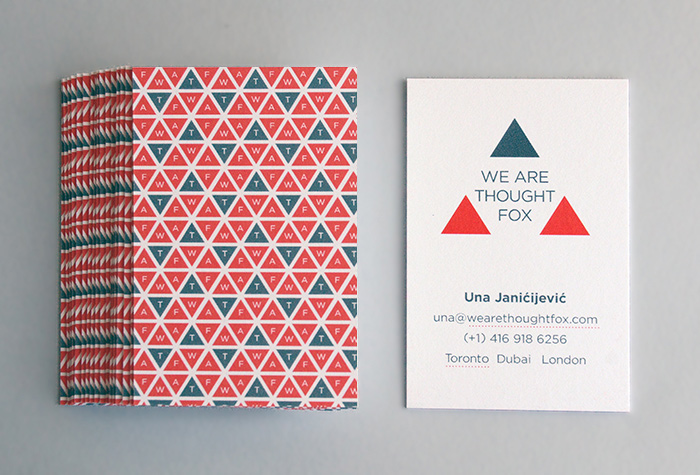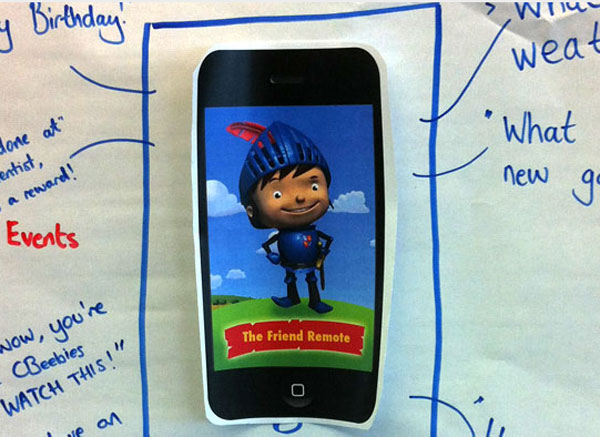Design Files: WATF Cards

Our new business cards have arrived!
Want some? Get in touch, we’re giving these babies out for free.

Our new business cards have arrived!
Want some? Get in touch, we’re giving these babies out for free.

Great design is central to We Are Thought Fox and our process respects the time required to achieve it. Each of us started off working in ‘traditional’ media and in many ways that helped teach us the fundamentals in a way that perhaps learning digitally wouldn’t have.
My design life started about 8 years ago when I graduated from Toronto’s weirdest landmark—Ontario College of Art & Design. Since then I’ve had the chance to design, art direct and illustrate for some of Canada’s most exciting publications and collaborate with some inspiring people.
Here are a few of the wild and wonderful projects I’ve been lucky enough to participate in:
I spent many late nights designing and making digital collages in a fast-paced news environment. After paying my dues, I was rewarded with digging through the magazine’s 100+ year history in order to inspire a magazine re-design and launch their revitalized online presence.
I contributed to a complete rebrand of the magazine with the intent to make it vibrant, contemporary and not-just-for-old-white-guys anymore! One particularly funny photo shoot had us corralling dogs in glasses & ties around a boardroom table.
As a design lead on a small team I worked on the strategy for Rogers communications iPad initiative. At the time we were pioneers in the land of tablet magazines so the challenges and rewards were equally great.
I worked on the launch of this vibrant city magazine’s extended family of publications: Stylebook, Cookbook, Real Estate, City Home, Weddings… This a was a labour of love that almost turned me into a snob, since I was constantly after the best new it-model/taco/cafe. Hectic yet rewarding, photo shoots had me running after an actress through a greenhouse, constructing a wedding cake out of cheese and riding a rickety bike up and down a busy street while a photographer snapped photos for a cover.
A range of digital and hand-made collages for Maclean’s, Coach House books, Report on Business and Sex, etc., on topics from literary wars to sex ed.
I’m currently inventing a brand new travel publication for an airport, but I can’t disclose the details. It’s a total dream project for me, since I’ve been enamoured with travel ever since I was a child. My parents even used to take me to the airport just to watch the planes take off.
The CMeebie project establishes a new relationship between the BBC and a child: a companion.
During a great talk by BERG’s Jack Schulze, he summed up how lots of software and connected things are starting to go beyond straightforward responses to interactions with the phrase: “there’s no more U in UI”. Then he showed this video of a quadrocopter juggling a ball:
That video sums up how software and connected things are starting to display qualities such as behaviour, motive and even agency.
That’s what we were exploring in this BBC prototype. But the relationship between the child and the CMeebie needs to be established at the correct level. Taking cues from existing discussions around companion-centred design, we decided the companion needed to be as “smart as a puppy” – far from being too smart to fail, the CMeebie needed to make endearing mistakes in its attempts to learn and improve. This approach reduces the chances of the so-called “uncanny valley” effect whereby users feel uncomfortable with an entity which behaves almost but not exactly like a human being.
Endearing failure is particularly important around the suggestions. The CMeebie is effectively the friendly face of a suggestion engine, gathering information about the child and using this information to serve relevant content to the child. It’s important that the CMeebie can get it wrong and then tries to use that information to improve in the future.
There’s no doubt companion-centred design is becoming a big thing. This experience building a digital companion for children was illuminating and satisfying and we’d love to explore this area further.
CMeebies is an idea that has emerged out of the third BBC Connected Studio around CBeebies, the BBC product for children up to six years old.
I went along to the day-long session at MediaCity UK, Salford and teamed up with some people to pitch an idea. It revolved around creating magic for children using technology, but combining it with nurturing elements to back up and give substance to the magic.
We called it a “CMeebie”. It is a digital CBeebies friend app that goes with you across all four screens and beyond.
Think of your CMeebie as a much-loved toy or invisible friend in the guise of a favourite CBeebies character. It’s a companion guiding you to the website, finding the stuff you like and showing you new stuff that you might like and it’s a friend that plays with you and sets you challenges via a mobile app.
After making it through the first and second stages of the process, it is now at the pilot stage. You can read more on the BBC website about the first set of pilots.
The team working on CMeebies is made up of people from the BBC Games Grid, Animated Yorkshire, Thought Den, We Are Thought Fox and @LisaAKendrick.
I can’t wait to get started!
The third BBC Connected Studio was around CBeebies, the BBC product for children up to six years old. I went along to the day-long session at MediaCity UK, Salford and teamed up with people from the BBC, Thought Den, Fettle Animation to pitch an idea. It revolved around creating magic for children using technology, but combining it with nurturing elements to back up and give substance to the magic.
As it turned out our idea wasn’t terribly original with another team pitching something similar, but it was one of ten to make it through to the next stage: the Build Studio, two days of rapid prototyping to develop the idea into a proof of concept.
One of the best things about the event was the unique collaborations going on: the BBC had paired all manner of different companies together to create interesting combinations of technical and creative groups. It was a bold move which added to the frenzied energy and made the event feel even more special.

We were a large team with various skills and this diversity made it difficult to focus at times. Yet the technical group knuckled down to create some interesting examples of how our idea might work on the web, while the creative group explored the full possibilities of the concept. This involved everything from planning interactions to sketching wireframes to developing user journeys.
The number of people from the BBC – from editorial to UX to technical – on hand to offer advice and feedback was wonderful. People like Jon Howard, Game and Web Development Team Leader, managed to impart enthusiasm, scepticism and knowledge in healthy doses at all the right moments. Thanks to the BBC Connected Studios team for organising it and making everything run smoothly. It was a brilliant few days.
We await the verdict in a few weeks about whether our idea was good enough to make it through to a full pilot.